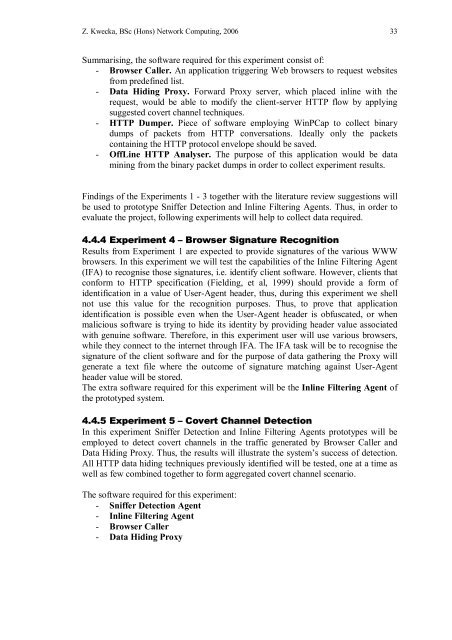Application Layer Covert Channel Analysis and ... - Bill Buchanan
Application Layer Covert Channel Analysis and ... - Bill Buchanan
Application Layer Covert Channel Analysis and ... - Bill Buchanan
- No tags were found...
Create successful ePaper yourself
Turn your PDF publications into a flip-book with our unique Google optimized e-Paper software.
Z. Kwecka, BSc (Hons) Network Computing, 2006 33Summarising, the software required for this experiment consist of:- Browser Caller. An application triggering Web browsers to request websitesfrom predefined list.- Data Hiding Proxy. Forward Proxy server, which placed inline with therequest, would be able to modify the client-server HTTP flow by applyingsuggested covert channel techniques.- HTTP Dumper. Piece of software employing WinPCap to collect binarydumps of packets from HTTP conversations. Ideally only the packetscontaining the HTTP protocol envelope should be saved.- OffLine HTTP Analyser. The purpose of this application would be datamining from the binary packet dumps in order to collect experiment results.Findings of the Experiments 1 - 3 together with the literature review suggestions willbe used to prototype Sniffer Detection <strong>and</strong> Inline Filtering Agents. Thus, in order toevaluate the project, following experiments will help to collect data required.4.4.4 Experiment 4 – Browser Signature RecognitionResults from Experiment 1 are expected to provide signatures of the various WWWbrowsers. In this experiment we will test the capabilities of the Inline Filtering Agent(IFA) to recognise those signatures, i.e. identify client software. However, clients thatconform to HTTP specification (Fielding, et al, 1999) should provide a form ofidentification in a value of User-Agent header, thus, during this experiment we shellnot use this value for the recognition purposes. Thus, to prove that applicationidentification is possible even when the User-Agent header is obfuscated, or whenmalicious software is trying to hide its identity by providing header value associatedwith genuine software. Therefore, in this experiment user will use various browsers,while they connect to the internet through IFA. The IFA task will be to recognise thesignature of the client software <strong>and</strong> for the purpose of data gathering the Proxy willgenerate a text file where the outcome of signature matching against User-Agentheader value will be stored.The extra software required for this experiment will be the Inline Filtering Agent ofthe prototyped system.4.4.5 Experiment 5 – <strong>Covert</strong> <strong>Channel</strong> DetectionIn this experiment Sniffer Detection <strong>and</strong> Inline Filtering Agents prototypes will beemployed to detect covert channels in the traffic generated by Browser Caller <strong>and</strong>Data Hiding Proxy. Thus, the results will illustrate the system’s success of detection.All HTTP data hiding techniques previously identified will be tested, one at a time aswell as few combined together to form aggregated covert channel scenario.The software required for this experiment:- Sniffer Detection Agent- Inline Filtering Agent- Browser Caller- Data Hiding Proxy









![Unit 5. Switches and VLANs [PDF]](https://img.yumpu.com/34422504/1/184x260/unit-5-switches-and-vlans-pdf.jpg?quality=85)






